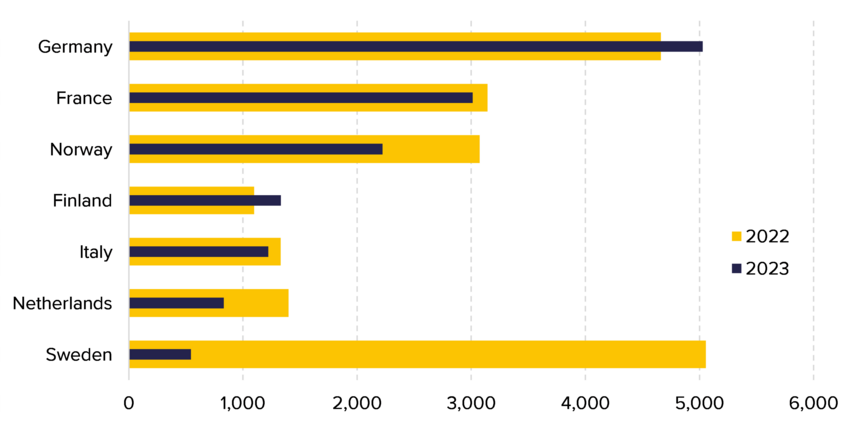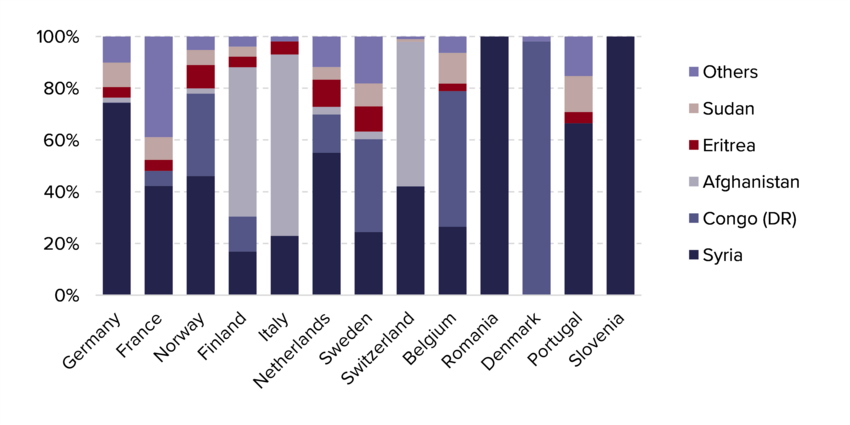3.14.1.2.1. Data on resettlement activities in 2023
In 2023, about 15,000 people arrived in the EU+ from third countries in the context of resettlement or humanitarian admissions.xliThe number of resettled persons peaked in 2021 but dropped by around one-fifth in 2022 and then again by one-quarter in 2023. In fact, resettlement figures in 2023 reached their lowest level since 2016, for the exception of the level in 2020 when transfers were severely hindered due to the COVID-19 pandemic.
Germany and France were the main receiving countries (in descending order), accounting for over one-half of all resettlements (see Figure 20). In Sweden, which was the top receiving country from 2017 to 2022, the number of resettled persons significantly dropped from 5,100 in 2022 to 540 in 2023.xliiNotable decreases also took place in Norway, the Netherlands and Switzerland (in descending order).
In contrast, Finland and Romania resettled the most refugees on record,xliiiand the number of resettled people more than quadrupled in Belgium, nonetheless remaining at lower levels than in the past.
Continued declining rates of resettlement in 2023
Figure 20. Top EU+ countries receiving resettled persons, 2023 compared to 2022

Syrians (7,600 in total) were resettled the most, accounting for one-half of all resettlements. In previous years, Syrians were the top resettled group in almost every EU+ country. However, in 2023 there was more variation: Afghans (2,000) were resettled the most in Finland, Italy and Switzerland and nationals of the Democratic Republic of the Congo (1,700) were the main resettled group in Sweden, Belgium and Denmark (in descending order) (see Figure 21). While the number of resettled nationals from Syria and the Democratic Republic of the Congo dropped by around one-third from 2022, Afghans were resettled more frequently than in the previous year.
Syrians accounted for one-half of all resettlements to EU+ countries
Figure 21. EU+ countries of resettlement by main citizenship of resettled refugees, 2023

Source: EUAA EPS data as of 1 February 2024.
Eritreans (810) and South Sudanese (350) were less frequently resettled than in 2022. At lower levels, there were other notable relative decreases for: Yemenis (74, down by over one-half), Ethiopians (64, down by four-fifths to the lowest on record), Burundians (51, down by around two-thirds), Egyptians (48, down by around two-thirds), Iraqis (36, down by four-fifths to the lowest on record), Nigerians (17, down by nearly 90%) and stateless persons (31, down by four-fifths).
Conversely, other nationalities were resettled more frequently, including nationals of the Central African Republic (530, the most on record), Somalia (360, more than double from 2022), Lebanon (153, previously no more than 7 had been resettled annually), Rwanda (98, the most on record) and Chad (70, the most on record).
In terms of countries of previous residence, two-fifths of all resettlements to the EU+ came from Türkiye and Lebanon, followed by Egypt (11%), Rwanda and Iran (8% each). Most Syrians came either from Türkiye or Lebanon, most Afghans came from Iran, and most nationals of the Democratic Republic of the Congo came from Rwanda.
In 2023, females and males were resettled in equal numbers.xlivWomen and girls were most prominent among resettled Afghans (57%) as well as for Congolese (DR), South Sudanese and Somalis (52% each).xlvNearly one-half of all resettled refugees were minors,xlviof whom four in every five were under the age of 14. The share of resettled minors was the highest among Lebanese (67%), followed by nationals of South Sudan and the Democratic Republic of the Congo (54% each). The shares of females and minors suggest that mainly families were resettled.
- xliBoth resettlement and humanitarian admissions are within the scope of the indicator on resettlement arrivals which is collected under the EUAA EPS data exchange. The data currently gathered, however, do not allow to establish accurately to which extent reporting countries provide data on resettlement or humanitarian admissions.
- xliiSince 2018, Sweden has been resettling around 5,000 refugees every year. However, in 2023, the government proposed a smaller quota of 900 refugees to arrive in Sweden in the context of resettlement (see Section 3.14.1.1).
- xliiiSince at least 2016.
- xlivFor 8% of cases, the sex of the resettled person was unknown.
- xlvOnly citizenships with at least 100 resettled persons were considered.
- xlviFor 8% of cases, the age group of the resettled person was unknown.

